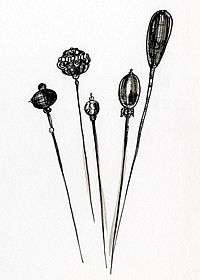Hatpin

A hatpin is a decorative and functional pin for holding a hat to the head, usually by the hair. In Western culture, a hatpin is almost solely a female item and is often worn in a pair. They are typically around 20 cm in length, with the pinhead being the most decorated part.
Production
The hatpin was invented to hold wimples and veils in place, and was handmade. In Britain, demand eventually outgrew the number that could be supplied by hand-making, and they began to be imported from France. In 1832 a machine was invented in America which could mass-produce the pins, and they became much more affordable. During the 1880s, bonnets gave way to hats, and the popularity of hatpins soared. They remained a standard women's accessory through the 1910s and were produced in a vast range of materials and types. Hatpin holder boxes were also produced.
Use in self-defence and as a weapon
Hatpins were sometimes used by women to defend themselves against assault by men.
Laws were passed in 1908 in America that limited the length of hatpins, as there was a concern they might be used by suffragettes as weapons. Also by the 1910s, ordinances were passed requiring hatpin tips to be covered so as not to injure people accidentally.[1] Various covers were made, but poorer women often had to make do with ersatz items like potato pieces and cork.
Collectibles
Hatpins are collectible items, and there is an American Hatpin Society for collectors in the United States and The Hat Pin Society of Great Britain for collectors in the United Kingdom.
References
- ↑ http://www.smithsonianmag.com/history/hatpin-peril-terrorized-men-who-couldnt-handle-20th-century-woman-180951219/
- Encyclopædia Britannica, hatpin. Accessed August 16, 2005.
- The Encyclopedia of Hatpins and Hatpin Holders by Lillian Baker
External links
| Wikimedia Commons has media related to Hatpins. |
- http://www.hatpinsociety.org.uk - Hat Pin Society of Great Britain
- "The Hatpin Peril" Terrorized Men Who Couldn't Handle the 20th-Century Woman - Smithsonian magazine article about hatpins being used as weapons.